IAR-81C výr. č. 426
Grupul 2 vanatoare /2. stíhací skupina/
Lt.av. Gheorghe Mociornita †
Vlčnov okr. Uherské Hradiště 21.4.1945

Bokorys IARu-81C v. č. 429 poručíka Mociornity vytvořený p. Bogdanem Patrascu/ pozn. motorový kryt byl pravděpodobně žluté barvy/
A.jpg)

Prostor dopadu letounu. Pohled směrem k Dolnímu Němčí.
Rumunsko se na přelomu třicátých a čtyřicátých let ocitlo ve velmi složité politické situaci. Jeho spojenectví s Československem a Jugoslávií, tzv. Malá dohoda bylo po "Mnichovu" minulostí a nový pakt se západními mocnostmi se nepodařilo uzavřít. Na východě se přitom stále zřetelněji začala rýsovat nová hrozba- Sovětský svaz, který přišel s požadavky na vrácení Besarábie a nově i odstoupení severní Bukoviny. Aby se vyhnulo vojenskému konfliktu, Rumunsko bolševikům ustoupilo a své území jim vydalo. S územními nároky přišlo ale i Maďarsko. I maďarským nárokům Rumunsko vyhovělo, ale tato další územní ztráta vyústila v to, že Rumunsko hledalo, a nakonec i našlo svého silného spojence - Německo, respektive země Osy. Tu tvořily v takzvaném paktu Tří mocností Německo, Japonsko a Itálie. Spojenectví s Německem trvalo do léta 1944, kdy bylo stále víc zřejmé, že Německo válku prohraje. Frontová linie se stále více blížila k rumunskému území. Je nepříjemné být v pozici poraženého a nevyjímá se to dobře ani v učebnicích dějepisu, a tak Rumunsko provedlo další obrat. Král Michal I. ohlásil 23.srpna 1944 ukončení spojeneckého svazku s Německem a jeho spojenci. Z vojenského hlediska znamenalo, že ke Spojencům přešlo přes jeden milion rumunských vojáků a tak, jak předtím odhodlaně bojovali proti bolševikovi, nyní se stejně odhodlaně pustili do svých někdejších německých kamarádů ve zbrani. Okupovaného Československa se vojenské operace Rumunů a společně postupující Rudé armády začaly intenzivněji dotýkat na sklonku roku 1944. Při podrobnějším studiu je až překvapivé, jak intenzivní tyto operace byly. S tím, jak se frontová linie posunovala směrem na západ se i stupňovala intenzita útoků rumunského letectva na německé cíle zejména na jižní Moravě. Rumunské letectvo masivně využívalo svých bitevních jednotek vybavených letouny Hs 129, Ju 87 a IAR 81 k úderům na německá seskupení vojsk. Tyto bitevní stroje chráněné stíhacími Bf 109 byly zvláště v dubnu a květnu 1945 denními návštěvníky na Moravě. Bojové akce se samozřejmě neobešly beze ztrát.
Již zpracované případy sestřelených rumunských letadel:
IAR-81 u obce Suchá Loz 26.4.45 ZDE
Ju 87D-5 u Biskupic dne 29.4 ZDE
Bf 109G-6 u obce Divoky 7.5.1945 ZDE

Lt. av. Mociornita / Zápisník Z´83/
Dne 21.4.1945 po poledni hlídkovala dvojice strojů IAR-81C (piloti Lt. av. Mociornita a Adj.Maj.av. Dumitru) v prostoru Suchá Loz - Dolní Němčí. Cílem bylo nalézt a napadat případné německé pozemní jednotky, které se v oblasti nacházely. Na silnici severně od Nivnice se v té době pohybovala kolona asi sedmi nebo osmi německých nákladních vozidel. Vojenská nákladní auta neunikla pozornosti rumunských letců, kteří neprodleně zahájili útok. Při první zteči se oběma letcům podařilo zapálit po jednom vozidle. Během zatáčky k dalšímu útoku Adj. Maj. av. Dumitru ztratil svého vedoucího ze zorného pole. Po druhém útoku na jednom poli spatřil něco bílého, což vyhodnotil jako použitý padák. Vedoucí se na rádiové výzvy neozýval, pilot se proto na domovské letiště vracel sám a ve 13:30 přistál. Co byl bílý předmět na poli, který Adj. Maj. av. Dumitru spatřil, to nevíme, pravděpodobně to padák nebyl. Jisté je, že letoun Lt. av. Mociotrnity dopadl na pole asi 50m od silnice spojující obce Vlčnov a Dolní Němčí na trati zvané Horní Rovná. Podle očitých svědků, jimž byl např. vlčnovský rodák p. Josef Pavelčík (o kterém ještě bude řeč) se pilot nacházel ve vraku letadla. Stroj byl spálený požárem a p. Pavelčík si ještě po desítkách let vybavoval ohořelé tělo pilota, které viselo ve vraku na ohořelých popruzích. Místo bylo v té době obsazené německými vojáky, kteří všechny místní zvědavce odháněli. Jak pan Pavelčík později vzpomínal, za několik dní fronta touto oblastí přešla, bylo po válce a na místě dopadu zůstal letcův hrob. Majitel pole odklidil vrak letounu k silnici, aby mohl na poli hospodařit. Pan Pavelčík tehdy uprosil svého otce a z vraku společně domů odtáhli výškové kormidlo a další součásti.
Tělo Lt av. Mociornity bylo krátce po válce převezeno do Vlčnova na hřbitov a pohřbeno zde jako "bezejmenný hrdina, poručík letec" společně s dalšími padlými rumunskými vojáky. Takto je to rovněž uvedeno na pomníku, který se ve Vlčnově nachází dodnes. Jeho jméno ale přeci jen nebylo v té době tak úplně neznámé. V seznamu padlých, kteří byli ve Vlčnově pohřbeni se totiž jeho jméno vyskytuje, byť zkomoleně - " MOCICIU Gheorghe, poručík, letec". Dne 9. dubna 1952 byly ostatky všech padlých vojáků znovu exhumovány a převezeny do Brna na hřbitov rumunských vojáků. Tam spočívá Locotenent aviator Mociornita (nar. 14.5.1919 Baivoi) dodnes.
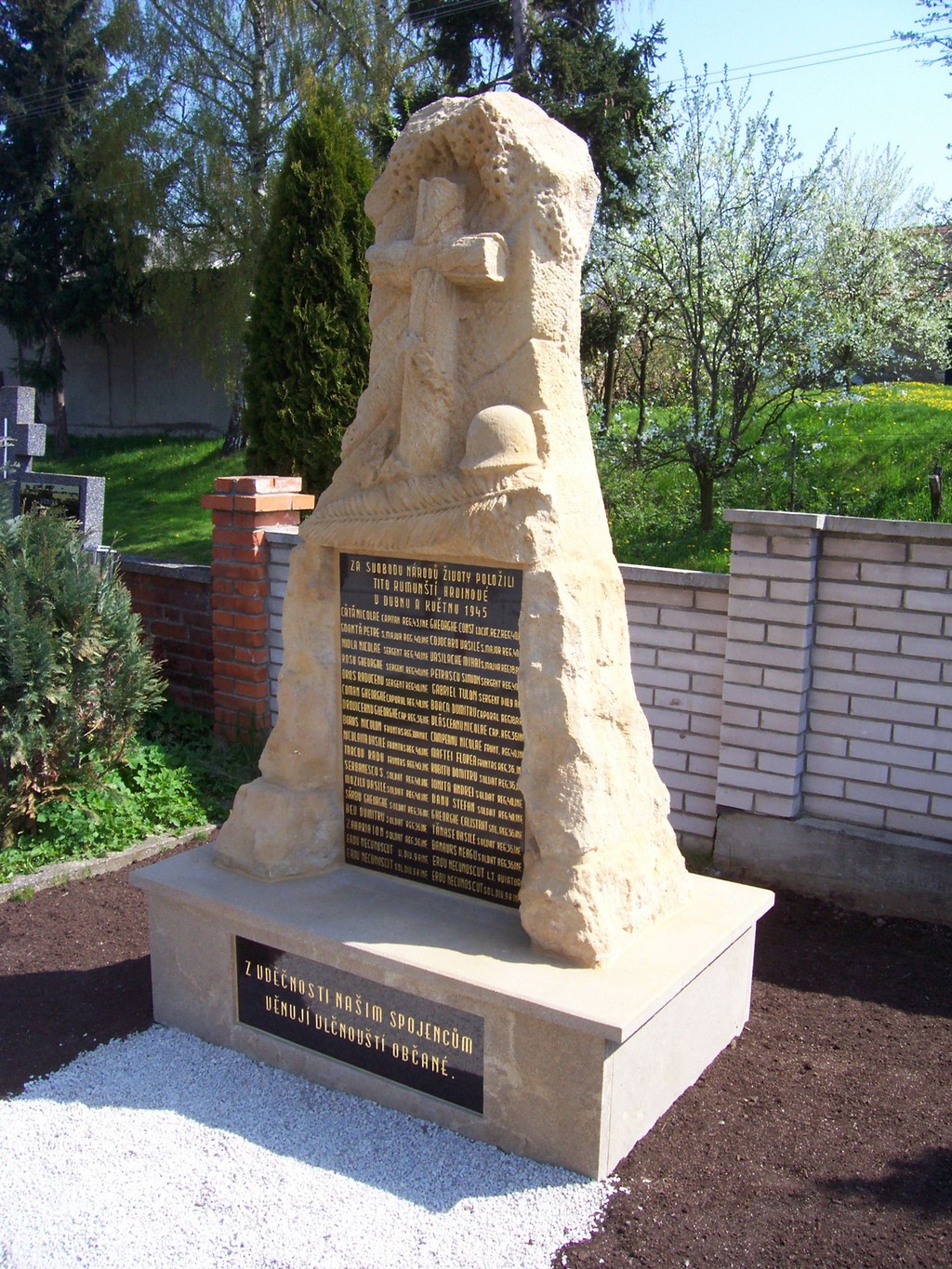
Pomník padlých vojáků na hřbitově ve Vlčnově.
Životopis poručíka Mociornity - Bogdan Patrascu /www.Worldwar2.ro/
Gheorghe Mociornita was born on 14 March 1919 in Baicoi, a town in the vicinity of Ploesti. He was teh fourth child of the eight the Mociornita family had. "Gellu", as the family called him, went to the school in his home town and then, for two years, to the Matei Basarab High School in Bucharest, where his literature talent was noticed by Perpessicius, following a paper on an oil well, which was burning for three years. He moved to Fagaras and was transferred to the Radu Negru High School. In 1938 he graduated from high school and was admitted into the Philosophy and Literature Faculty in Bucharest. But in 1940 he was mobilized in the army and had to temporarily quit his studies. However he chose to follow a childhood passion and in the autumn the same year he was admitted into the Air Force Officer School.
He made his first flights on a Fleet F-10G at Otopeni. In May 1941 the school moved to Turnu Severin where they continued to train on this type of aircraft and then passed on to the IAR-27. He had as flight instructor adj. av. Constantin Serbanescu.
On 10 May 1942 he graduated from the Air Force Officer School, 37th from 112 students (according to the Royal Decree 1391/1942). The fresh sublocotenenti (2nd lieutenants) were assigned to Calarasi, where they began flying on Nardi FN-305s so that they could be selected for the different branches of the air force. He was admitted in the fighter corps and continued training on the PZL P.11c. On 30 September they finished the fighter school with 120 flight hours. Then came the Special School at Zilistea.
On 15 January 1943 slt. av. Gheorghe Mociornita received the military pilot license no. 2589. On 26 June he was transferred to the Fighter School in Galati, which was under the direction of German instructors. There he had two accidents: on 6 August he crash-landed the IAR-80 no. 27 and on 29 September the IAR-80A no. 134, both while landing.
He graduated this last school on 3 November 1943 and was assigned to the 64th Fighter Squadron from the 1st Fighter Group, which was equipped with IAR-80Bs and IAR-81As rearmed with 20 mm guns. It was commanded by cpt. cdor. av. Ioan Sandu. But he did not remain for long in this unit, because he was transferred to the 66th Fighter Squadron from the 2nd Fighter Group, which was equipped with IAR-81Cs. In 1944 it was based on the Ianca airfield.
Because the front had reached Romanian territory, the more experienced 7th Fighter Group was pulled out of the Bucharest's defences at the end of April 1944 and sent in Moldavia, where it was subordinated to the 1st Air Corps. Its place was taken by the 2nd Fighter Group, which started arriving on the Pipera airfield on 19 April. Their first dogfight took place two days later, when the American bombers made yet another raid. All 34 aircraft the group possessed were airborne, but the lack of experience and the presence of enemy fighters (for the first time since the USAAF had returned into Romanian airspace on 4 April 1944) resulted in the loss of 5 aircraft and a sixth made a crash landing. Two pilots were killed and three wounded. And this after only one squadron encountered the American airplanes. It seems four B-24s were shot down.
The IAR-80, although a very good fighter when it was introduced into service in 1941, it had become obsolete and it wasn't capable of challenging the P-38s and P-51s at high altitudes.
Despite these setbacks, the IAR-80 fighter groups continued to fight and score kills. On 5 May 1944 the 2nd Fighter Group put 25 IAR-81Cs in the air. No less than ten American bombers were claimed shot down, of which seven were later confirmed, among which the downed by slt. av. Gheorghe Mociornita. It was his first kill, which brought him 3 victories. However he ran out of gas and had to make a belly landing at Pietroasa, Prahova county.
The 15th Air Force returned the following day. The 2nd Fighter Group opposed them with 23 IARs. Again there were some impressive claims: 14 B-24s, of which 12 confirmed. Slt. av. Mociornita increased his score to 6 victories (according to the ARR point system). But the group lost another pilot.
On 10 May the group was split into two: the 65th and 66th Squadrons were moved to Petrosani and the 67th Squadron to Ianca. The next American raid was on 18 May. The 2nd Fighter Group raised in the air only 16 IAR-81Cs that day. Only two claims were confirmed, among which another B-24 shot down by slt. av. Gheorghe Mociornita. It was his last kill during the war.
Because it was pretty clear that the IARs weren't too much of a match for the P-38s and P-51s it was decided to bring back the 7th Fighter Group from the front and replace it there with the 2nd Fighter Group. The operations against the VVS were less demanding as far as aircraft performance was concerned and it was hoped that the IAR-80s would fare better in Moldavia.
The first mission in the new theatre of operations were flown on 30 May, from the Gheraesti airfield. These were generally bomber escort missions and he did 6 of them plus 3 free-hunts until 5 August when he had an accident. He was test-flying the IAR-81C no. 441 and the engine stopped before landing and he barely made it, hitting the CO's car in the process.
On 23 August 1944 he was home, resting. His father took him in a cart to Targsor, where the HQ of the 2nd Fighter Flotilla was. From there he was directed to his unit at Geamana. He arrived there on 28. On 1 September he was on his way to the front in Transylvania, against the doctor's recommendations not to, because he had appendicitis.
On 16 September, Gheorghe Mociornita was part of a formation of six IAR-81Cs, which escorted He-111H6s of the 78th Bomber Squadron over Apahida railway station. On the way back home two Luftwaffe Bf-109Gs attacked the Romanian formation and Uffz. Heinrich Tammen of 6./JG 52 shot down and killed adj. av. Iosif Ciuhulescu flying the IAR-81C no. 413. Almost the same thing the following day, only that the victor was Hptm. Peter Dütmann, who had already claimed an IAR-80 earlier that day, probably the one flown by adj. av. Victor Popescu, which was damaged over Cluj. In both cases slt. av. Mociornita and his wingmen were prevented from intervening before the German Bf-109 got away by the inferior speed of their aircraft. Until the end of September, he flew another six missions.
The 2nd Fighter Group had suffered severe losses at the hands of the Luftwaffe and in October it was reorganized and reequipped. The 67th Fighter Squadron was disbanded and the 6th Fighter Group transferred its remaining IARs to the 2nd.
On 7 November, Gheorghe Mociornita was promoted to the rank of locotenent (1st lt.). The unit moved to Türkeve, in Hungary. From there, it started carrying out the new kind of missions assigned to the IAR-80s: harassing enemy supply lines. Thus, on 17 November, Mociornita destroyed a truck and five days later, two out of the five cars the Romanians left behind burning on the road.
During February and March 1945 he was back in Romania, ferrying new aircraft for the group, from Someseni to Lucenec, in Slovakia.
On 21 April 1945, he took off at 9:25 in front of a patrula, which attacked two infantry platoons near the Soha Lova village and then strafed the road nearby. By 10:20 they were back at the airfield. After two hours he took off again, but this time only with his wingman adj. av. Dumitru Silivan. Their mission was to patrol the road between Soha Lova and Dolny Nemec. They spotted a column of about 7-8 trucks and attacked, each of them destroying one truck. When they came around for a new pass, adj. av. Silivan did not longer see his leader. Instead he saw a big white spot on the field. The IAR-81C no. 426 of lt. av. Gheorghe Mociornita had been hit by a quad machine-gun mounted on one of the trucks. The locals later found him in the cockpit, with his legs cut and a bullet hole in his forehead. The white parachute had been spread out and cut into pieces by the German soldiers. That was probably what Silivan saw. He was buried in the Velnov cemetery, together with 33 other Romanian soldiers. He would have been 26 in several days. In his honor, in 1991, the 86th Fighter Group was given the name Locotenent aviator Gheorghe Mociornita.
Lt. av. Gheorghe Mociornita shot down just 3 aircraft, but the point system of ARR brought him 9 victories, thus achieving the ace status. What is notable is that these kills were obtained only in 29 missions. He has also destroyed several trucks and carts on the ground, after the 2nd Fighter Group was relegated to a ground attack role. His less known side was the artist in Gheroghe Mociornita, who had written several poems and drew with amazing dexterity.
Případ sestřelu rumunského letadla ve Vlčnově a okolních obcích po válce pozvolna upadal do zapomnění . Teprve až po několika desítkách let se prach usedlý na události znovu rozvířil. Bylo to v roce 1979 poté, se o události dozvěděla skupina, která se při časopisu "Zápisník" zabývala objasňováním případů letců, kteří zahynuli při osvobozování Československa. Podnět k tomu dal dopisem do redakce p. Josef Knotek z Vlčnova, který byl rovněž očitým svědkem události. Redaktor Zápisníku Jindřich Drebota se na základě tohoto dopisu vydal do Vlčnova. Ve stodole již dříve zmíněného pana Pavelčíka si pak prohlédl zachovalé trosky stroje, které tam desítky let přečkaly. Při dalším pátrání po identitě zahynulého letce byla oslovena ambasáda Rumunské socialistické republiky, jejíž letecký přidělenec plk. Voucu Tugerel přislíbil pomoc vojenského archivu v Bukurešti. Po několika letech byla událost objasněna a výsledek celého pátrání publikován 22.5.1983 v 15. čísle časopisu Zápisník. O unikátní části letounu, mezi nimiž bylo celé výškové kormidlo stroje neprojevil VHÚ zájem, v létě 1988 přijeli do Vlčnova zástupci rumunské armády a po předběžném jednání všechny části stroje odvezli do Národního vojenského muzea v Bukurešti, kde se staly trvalou součástí sbírky.

Zápisník Z´83 č. 15
V r. 2020 se mi ozval vnuk p. Pavelčíka, pan Dušan Švestka. Při mé návštěvě v lednu 2021 ve Vlčnově se mi dostalo nejen srdečného slováckého pohoštění, ale pan Švestka poskytnul pro Badatelnu i sérii fotografií, které zachycují artefakty z letounu poručíka Mociornity.
A.jpg)
Rok 1979, Jindřich Drebotav(vlevo) z redakce časopisu Zápisník a Josef Knotek obhlíží výškové kormidlo IARu-81C v.č. 426
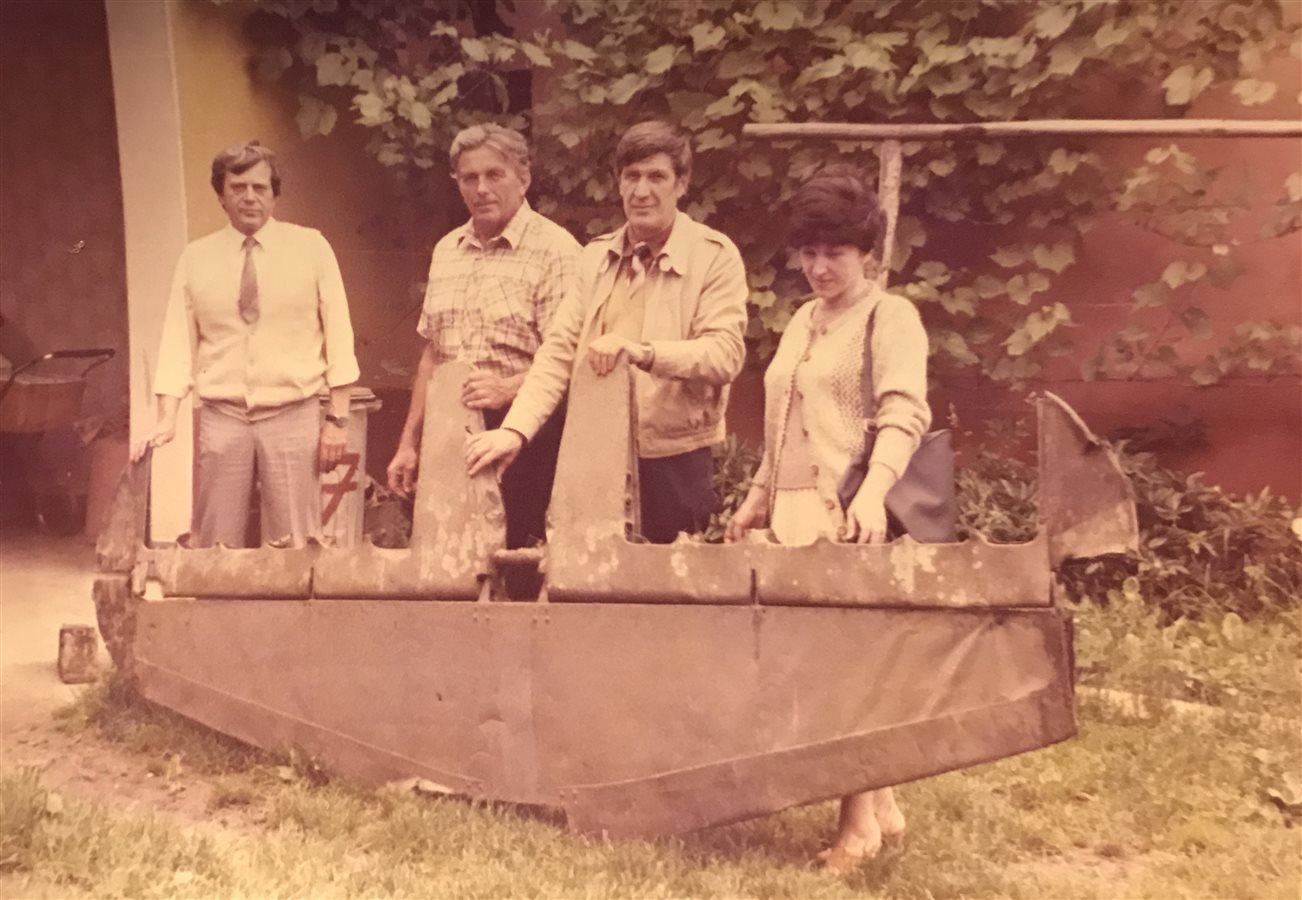
Rok 1988, převoz částí letadla do Rumunska.
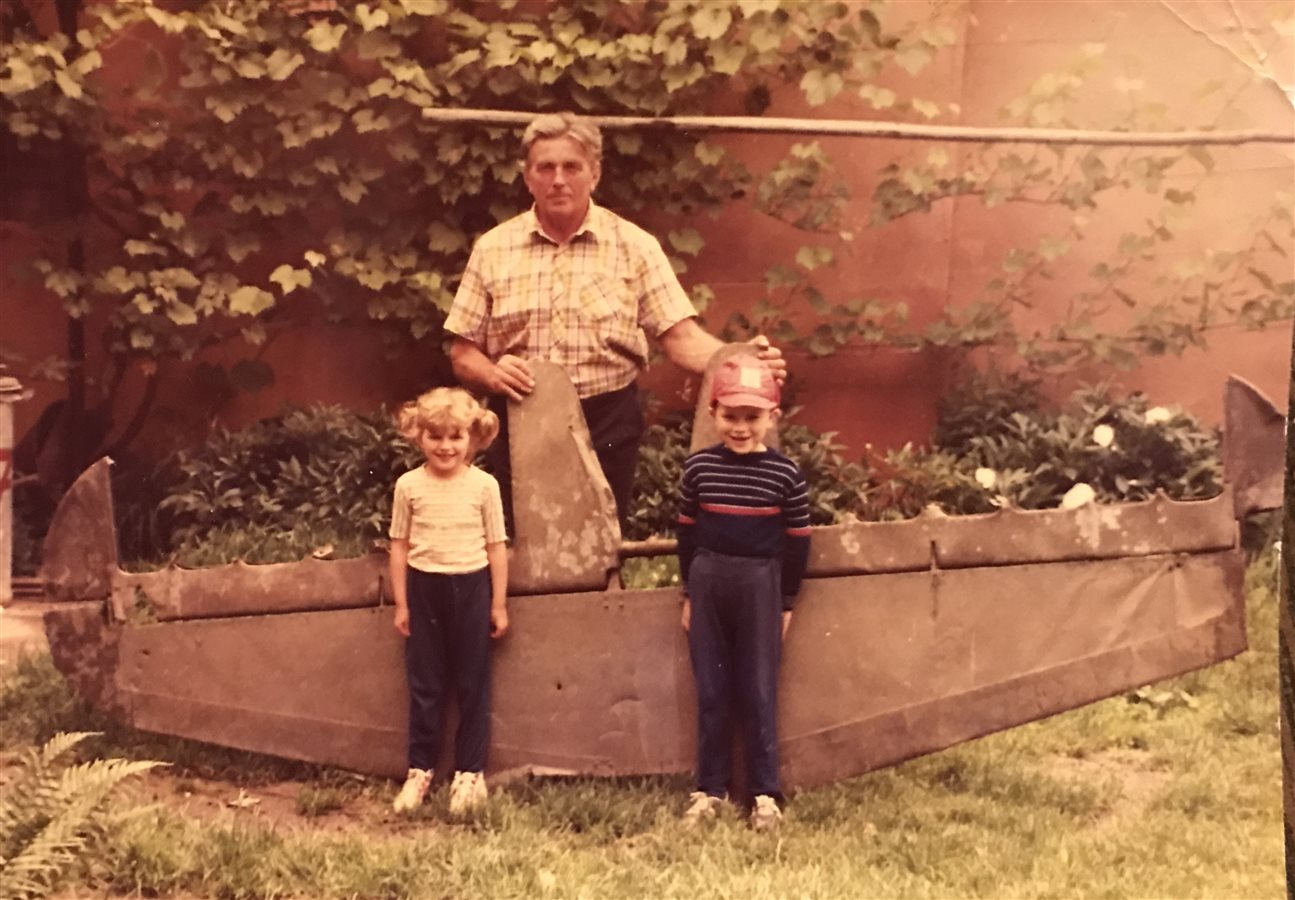
Pan Pavelčák, který v r. 1945 se svým otcem zachránil před zničením výškové kormidlo a další součásti. Chlapec vpravo je jeho vnuk Dušan Švestka, který snímky autorovi v r. 2021 poskytnul.
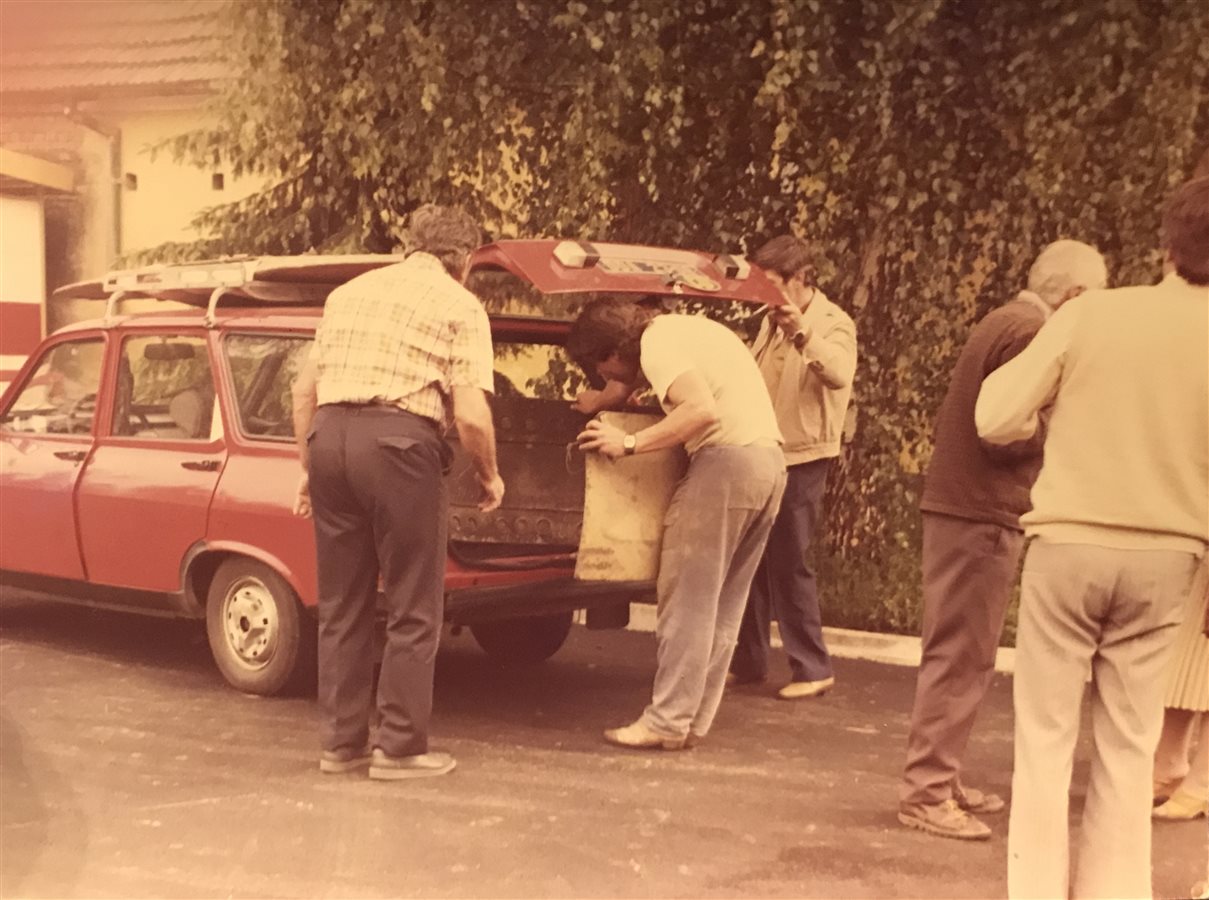
Ze snímku je patrné, že motorový kryt má žlutou barvu.
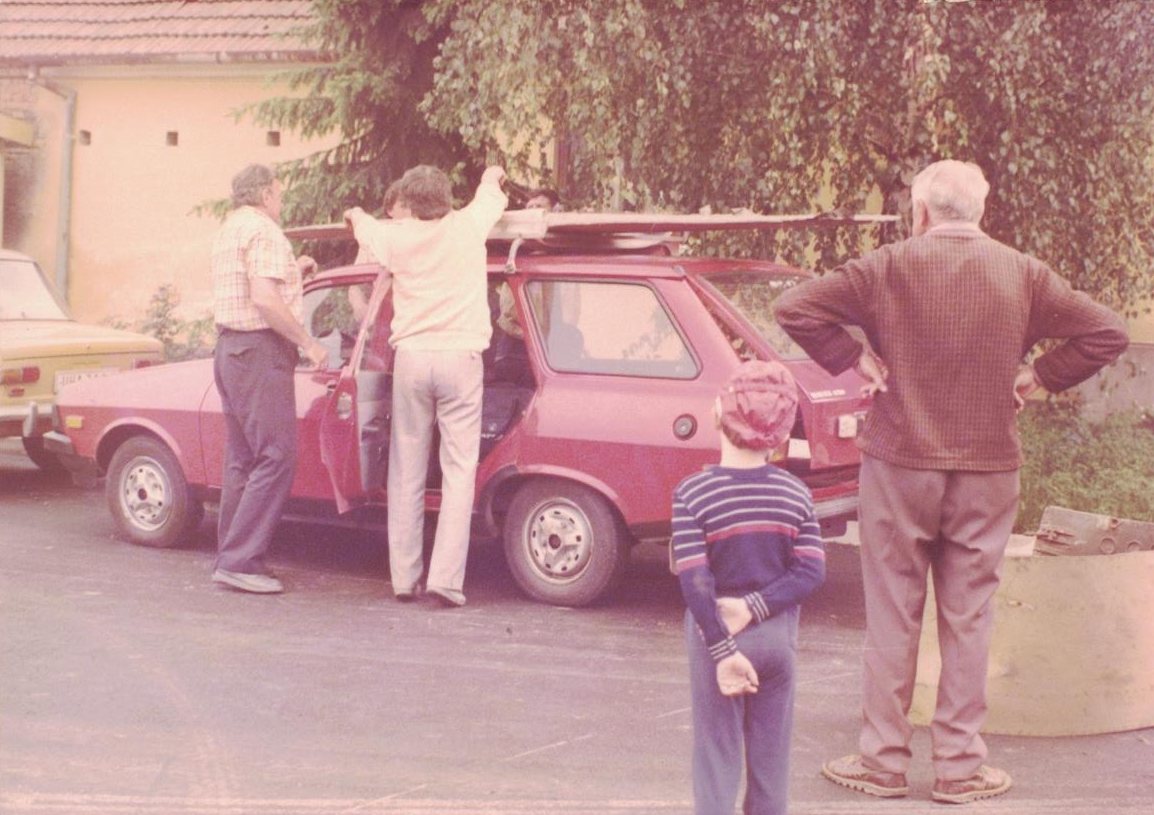
Nakládání částí letadla. Výškové kormidlo se do Dacie nevlezlo, putovalo na střeše.
Místo dopadu letadla jsem se pokoušel společně s p.Radovanem Fraitem nalézt v roce 2010. Tehdy jsme nebyli úspěšní, neměli jsme přesné informace. Místo bylo nalezeno až 25.11.2018 pány Markem Jančou a Dušanem Švestkou.
Drobné úlomky stroje nalezené na místě dopadu v posledních letech /Dušan Švestka/
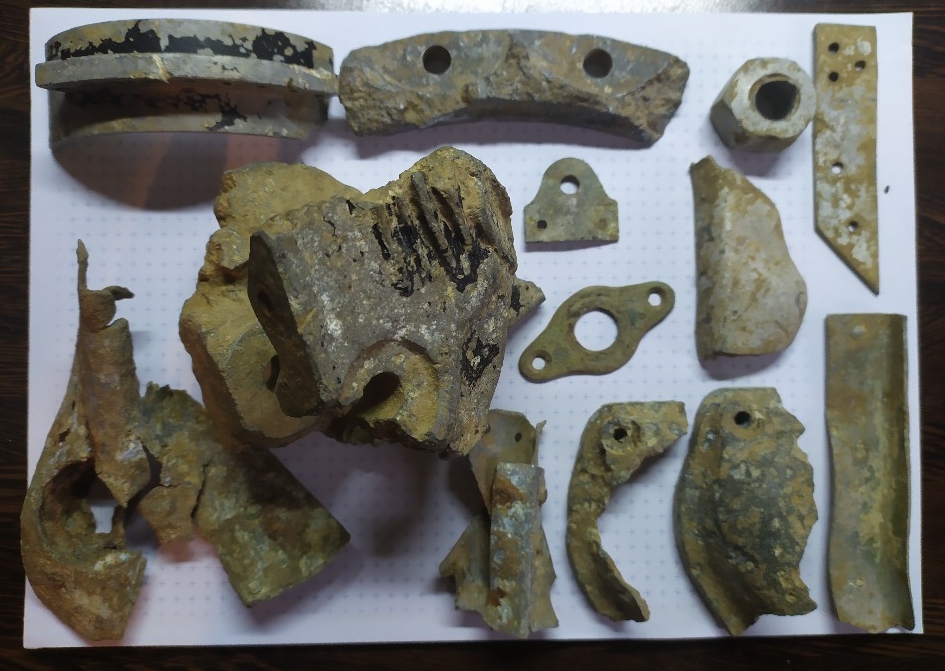
 |
 |
| Zámek krytu / vlevo/ | Slitek kovu svědčící o požáru vraku letounu |
 |
 |
Fragment krytky, kontrolní značky
Prameny:
- rodinný archiv Dušan Švestka
- archiv radovan Frait
- Zápisník Z´83
- "Rumunské kokardy nad Československem" /M. Cibula, P. Kaššák, R. Frait/ Degart s.r.o. 2019
Pavel Krejčí 2.2021
